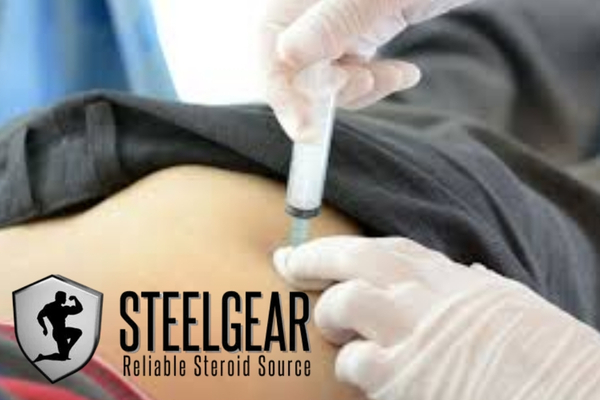Best Time to Inject Steroids for Maximum Effectiveness and Safety
Timing matters when it comes to steroid injections. Whether your goal is building muscle, speeding up recovery, or managing a medical condition, when you inject can influence results. The right timing helps maximize benefits while reducing risks like side effects or wasted dosages. Factors like your activity schedule, the type of steroid, and your goals all play a role. In this post, you'll learn how to time your injections for safety and optimal effectiveness.
Understanding the Purpose of Steroid Injections
Steroid injections serve various purposes, from treating medical conditions to enhancing athletic performance. Knowing the reasons behind their use can help you understand why timing injections correctly is so important. Below, we'll explore the different types of steroids, the health conditions they treat, and their role in sports and fitness.

Types of Steroids and Their Applications
Steroids come in two primary types: anabolic steroids and corticosteroids. The key difference lies in their purpose and how they affect the body.
Anabolic Steroids: These are synthetic versions of testosterone, a hormone that plays a vital role in muscle growth and recovery. They're often used by athletes and bodybuilders to build muscle, increase strength, and boost performance. Though commonly associated with sports, anabolic steroids are also prescribed in medical settings for conditions like muscle-wasting diseases.
Corticosteroids: These are designed to mimic cortisol, a hormone your body naturally produces to reduce inflammation and suppress the immune system. Unlike anabolic steroids, corticosteroids are not used for muscle-building. Instead, they treat inflammation, pain, and overactive immune responses in conditions like arthritis or lupus.
By understanding which type of steroid you’re dealing with, you can see why injection timing and dosage matter so much to achieving the desired effects.
Medical Conditions Treated with Steroids
Steroid injections are a common tool for managing numerous health issues. Medical professionals frequently prescribe them to help patients find relief from symptoms when other treatments fall short. Here are a few common conditions where steroids are prescribed:
Arthritis: For those with joint inflammation caused by rheumatoid arthritis or osteoarthritis, corticosteroid injections can reduce swelling and relieve pain.
Asthma: Inhaled corticosteroids are often used, but injections may be considered for severe cases where quick relief is necessary.
Autoimmune Disorders: Conditions like lupus or multiple sclerosis can cause the immune system to attack healthy tissues. Corticosteroids help regulate these overactive responses.
Allergies: For severe or chronic allergic reactions, steroids can manage symptoms by calming the body’s inflammatory response.
Steroids paired with other treatment plans often improve quality of life for millions of people struggling with challenging medical conditions.
Steroid Use for Athletic Performance
Anabolic steroids are the go-to for individuals looking to enhance their athletic performance or physical appearance. While they’re controversial due to misuse in sports, their intended purpose is directly tied to muscle development and recovery.
Muscle Growth: Steroids accelerate protein synthesis, allowing muscles to repair and grow faster after strenuous exercise. For bodybuilders, this means noticeable gains in size within a shorter timeline.
Performance Enhancement: By increasing strength and reducing fatigue, anabolic steroids can help athletes perform at higher levels, whether they’re training or competing.
Recovery: Hard training takes a toll on the body. Steroids speed up the recovery process, allowing athletes to hit the gym or the track more frequently and with less downtime.
While the benefits may be appealing to athletes, misuse can lead to significant health risks. Timing, proper dosing, and professional guidance are essential to avoid complications.
Understanding the purpose behind steroid injections—medical or athletic—puts into perspective why careful planning matters. Whether it’s for inflammation control, better recovery, or performance improvement, timing is a key factor in achieving results safely.
Factors Influencing the Timing of Steroid Injections
When it comes to steroid injections, timing isn’t just a small detail—it’s a major factor in how effective the treatment or performance enhancement will be. Getting it right ensures the steroid is working with your body, not against it. Here’s a breakdown of the key factors impacting the optimal injection schedule.
Body's Natural Hormonal Rhythms
Your body runs on a 24-hour cycle, called the circadian rhythm, which affects hormones like cortisol and testosterone. These natural fluctuations can influence how your body responds to steroids. For instance:
Testosterone levels are typically higher in the morning. If you’re injecting anabolic steroids to mimic or supplement this hormone, it may make sense to time your doses early in the day for a more natural alignment.
On the other hand, corticosteroids may be better injected in the evening if the goal is to manage inflammation that tends to worsen overnight.
Matching your injection schedule to your body’s cycles can boost effectiveness. It’s like syncing to your body’s internal clock instead of fighting against it.
Goals of Steroid Use
What you’re hoping to achieve with steroid injections can heavily influence when to administer them. Your goals—whether health-related or performance-focused—play a huge role in deciding the timing.
Performance Boost: Athletes looking for an edge in strength or endurance may target injections a few hours before a workout or competition. This ensures the steroid is active during peak physical activity.
Recovery and Muscle Growth: If your aim is faster recovery, post-workout injections might make more sense. This allows your body to repair and rebuild when it’s primed for recovery.
Medical Treatment: When prescribed for conditions like arthritis or allergies, timing will often follow your doctor's advice to manage flare-ups. For example, an injection in the morning could relieve symptoms throughout the day when you're most active.
Determining the best time depends on your specific objective. Think of steroid timing as part of customizing your overall plan—not as a one-size-fits-all rule.
Frequency of Dosing and Absorption Rates
Not all steroids work the same way. Some act quickly and fade fast, while others release their effects slowly over time. This variation directly impacts how often, and when, injections should happen.
Short-acting steroids: These have a quick onset but wear off within hours or days. Injections need to be more frequent to maintain effective levels.
Long-acting steroids: These release slowly, sometimes over weeks. For this type, timing is less about hours and more about sticking to a consistent schedule.
Absorption rates also matter. Steroids administered intramuscularly might be released over a longer period compared to those injected subcutaneously. Understanding the half-life of the specific steroid you’re using can help refine your timing. Keep in mind that consistency is key with steroids—just like maintaining a steady rhythm in a song.
No matter the type, tailoring your schedule around how the steroid works will ensure you get the maximum benefits with minimal waste.
Ideal Timing for Specific Applications
The timing of steroid injections plays a significant role in achieving desired outcomes, whether for athletic performance, medical relief, or long-term cycle management. The right timing not only optimizes effectiveness but also reduces potential risks. Below, we break down ideal timing strategies based on the specific application.
Timing for Performance Enhancement
For athletes and bodybuilders, timing steroid injections around their training schedule can maximize both performance and recovery. Here's how to approach it:
Pre-Workout Timing: If you're using anabolic steroids to enhance strength, energy, or endurance during workouts, injecting a few hours before your session can help. This gives the steroid time to circulate through your bloodstream, providing optimal benefits when you need them most. Plan injections based on the half-life of the steroid to ensure peak levels during exercise.
Post-Workout Recovery: If the main goal is to speed up muscle repair and reduce fatigue, consider administering the injection shortly after your workout. This aligns with the body’s natural recovery window, where muscles are actively repairing and growing.
Rest and Off-Days: Even on rest days, maintaining consistency in timing is crucial. Use these days strategically to keep hormone levels stable or prepare for your next workout. Skipping or altering your schedule too much can cause fluctuations and reduce overall results.
The key for performance-focused use is consistency and aligning injections with your physical activity patterns.
Timing for Medical Use
When steroids are prescribed for medical treatments, timing often depends on the condition being treated and the nature of the medication. Medical professionals carefully schedule these injections to provide the most relief with minimal side effects. Here’s what to consider:
Chronic Conditions (e.g., Arthritis): Corticosteroid injections for joint pain or inflammation are typically given during flare-ups. Doctors often recommend scheduling these injections earlier in the day so symptoms don’t disrupt daily activities. However, frequency is usually limited (e.g., no more than once every 3 months per joint) to prevent potential joint damage.
Severe Allergies or Asthma: In cases of immune or pulmonary distress, corticosteroids might be injected during peak symptom periods. Timing will vary, but often it aligns with episodes where symptoms are at their worst, such as during allergy seasons or respiratory triggers.
Autoimmune Disorders: When used for conditions like lupus or multiple sclerosis, corticosteroid schedules may revolve around flare-ups or treatment phases. Doctors may schedule injections early in treatment cycles to reduce inflammation quickly, helping to stabilize the patient before moving to maintenance.
For medical use, following a doctor’s timing recommendations is non-negotiable. The focus is managing symptoms effectively rather than optimizing for personal preferences.
Considerations for Long-Term Steroid Cycles
Long-term steroid cycles require more precise planning, as timing can vary depending on the phase you’re in: starting, cruising, or coming off. Here’s a breakdown:
Kickstarting the Cycle: At the start of a cycle, injections often need to happen more frequently to build baseline levels quickly. For shorter-acting steroids, this can mean daily or every-other-day injections. Long-acting steroids may only need to be injected weekly during the same phase.
Mid-Cycle Maintenance: Once levels stabilize, timing becomes about consistency. For example, scheduling injections at the same time every week helps keep hormone levels even, minimizing dips or spikes that could disrupt progress.
Post-Cycle Adjustments: Toward the end of a cycle, tapering off injections needs to be timed carefully to allow your body to begin producing its natural hormones again. This includes coordinating with post-cycle therapy (PCT), which often begins a few days or weeks after your final injection, depending on the type of steroid used.
In long-term cycles, timing is about planning the entire cycle in phases, not just individual injections. Treat it like a roadmap: clear steps ensure you’re moving toward your goal safely and efficiently.
By focusing on timing, you can optimize steroid injections for your specific needs—whether performance, medical, or long-term plans. Proper timing isn’t just smart—it’s essential for success.
Safety and Risks of Improper Timing
Properly spacing steroid injections isn’t just about maximizing results—it’s about safeguarding your health. Poor timing can lead to serious complications that offset any potential benefits. Let's break down the risks and how to stay safe.
Health Risks of Overlapping Injections
When injections are poorly timed or crammed too close together, the body can face significant challenges. Steroids are powerful substances, and their misuse can come back to haunt you. Here’s a closer look at what can go wrong:
Overdosing: Injecting too frequently increases the risk of taking more than your body can handle. In serious cases, this overload can lead to toxicity or unexpected medical emergencies.
Hormonal Imbalances: Steroids throw your natural hormone production off balance. Ill-timed or overlapping injections can trigger swings in testosterone or cortisol levels, disrupting everything from mood to metabolism.
Tissue Damage: Your muscles and injection sites need time to recover in between doses. Repeatedly hitting the same spots without enough rest can cause scar tissue, infections, or painful abscesses.
Think of your body like a scale: too much weight on one side throws everything out of balance. The same goes for injection timing—it’s about precision, not quantity.
Side Effects Amplified by Poor Timing
Steroids already have their fair share of side effects, even when used carefully. But improper timing can make them worse or cause new problems to pop up. Here’s how bad timing can magnify the issues:
Mood Swings: Steroids are notorious for throwing emotions all over the place, but poor timing can amplify this. Instead of mild irritability, you might end up dealing with full-blown aggression or depression.
Acne and Skin Issues: Hormonal fluctuations caused by mistimed dosing can lead to breakouts or worsen pre-existing skin conditions. Your skin reflects your body’s turmoil, and bad timing makes it obvious.
Joint and Muscle Pain: Some steroids cause fluid imbalances, which can affect joints. Skipping doses or squeezing injections too close together can worsen stiffness or discomfort.
Mistiming injections is like throwing fuel on a fire—what’s manageable can quickly spiral into something overwhelming. Your body likes consistency, and disrupting that rhythm comes with consequences.
Strategies for Safer Injection Practices
The good news? There are straightforward ways to reduce risks and keep things on track. A bit of planning and mindfulness can make all the difference. Here are some tips:
Consult a Professional: This one’s non-negotiable. Always work with a doctor or specialist to map out the safest dosing schedule. They’ll factor in your goals, health history, and the type of steroid you’re using.
Track Your Doses: Keeping a simple log of the date, time, and dosage of each injection goes a long way. It helps you stick to the right timing and avoid accidentally overlapping injections.
Rotate Injection Sites: Repeatedly using the same spot can cause irritation or even long-term damage. Alternate injection points to give each area enough time to heal.
Monitor for Side Effects: Pay attention to how your body reacts. If you notice warning signs like swelling, severe mood changes, or unusual pain, it might be time to adjust your schedule or seek medical advice.
Think of these strategies as your injection playbook. Following them not only reduces risks but also helps you achieve smoother, safer results. Remember, proper timing isn’t a “nice-to-have”—it’s an essential part of the process.
Expert Recommendations and Real-Life Examples
When it comes to steroid injection timing, expert advice and real-life results offer valuable guidance. Healthcare professionals provide science-backed recommendations to enhance safety, while athletes share practical insights based on trial and error. By learning from both, individuals can refine their strategies for better results.
Common Guidelines From Medical Professionals
Healthcare experts place a strong emphasis on timing injections to align with your body’s needs and the type of steroid being used. Their guidelines are often based on the steroid’s purpose, half-life, and how it interacts with your system.
Corticosteroids: Doctors often recommend timing injections for inflammation-related conditions, like arthritis or asthma, in the morning. This aligns with your circadian rhythm, minimizing interruption to daily activities. For localized issues, injections are placed directly at the problem site, with intervals between doses to prevent tissue damage.
Anabolic Steroids: Physicians supervising therapeutic anabolic steroid use often suggest administering these in the morning when natural testosterone levels peak. This approach helps limit hormonal disruptions. Consistent scheduling—whether weekly or biweekly—is critical to maintaining stable hormone levels and avoiding side effects such as mood swings or energy dips.
Medical guidelines stress the importance of creating a plan tailored to your individual health profile. Regular consultations with a medical professional ensure that your timing remains optimized for safety and efficacy.
Athlete Experiences and Anecdotes
Athletes, especially those in bodybuilding and high-performance sports, have developed personal timing strategies based on real-world trial and error. Their experiences provide practical insights into injection timing for performance and recovery.
Pre-Workout Injections: Many athletes prefer injecting anabolic steroids several hours before a workout. They claim this timing allows the steroid to stabilize in their system, boosting strength and endurance during training. For shorter-acting steroids, timing injections closer to the workout ensures peak levels during intense activity.
Post-Workout Timing: Some bodybuilders swear by post-workout injections to enhance muscle recovery. They believe this aligns with the body's natural repair window, as muscles are actively repairing micro-tears caused by exercise.
Competition Prep: Athletes preparing for competitions often adjust their timing based on the type of steroid and performance goals. For example, short-acting steroids are used closer to events, while long-acting steroids are started earlier in training cycles for consistent results.
Keep in mind that these anecdotes reflect personal experiences and may not guarantee universal success. What works for one athlete might not work for another due to differences in metabolism, goals, and steroid types.
How to Adjust Timing Based on Results
Steroid injection timing isn’t a “set it and forget it” process. Monitoring your body’s response and adjusting as needed can make a big difference in results. Here’s how to refine your approach:
Track Your Response: Pay attention to how your body feels after injections. Are you noticing better performance during workouts? Is inflammation improving after a corticosteroid injection? Keeping a log of timing, dosage, and results helps identify trends.
Watch for Side Effects: Timing changes might be needed if side effects appear. For example, if a morning injection leaves you feeling overly jittery, shifting to evening might help. Similarly, if post-workout injections cause excessive soreness at the administration site, a pre-workout injection might be a better option.
Test and Tweak: Adjust in small increments. Shift injection times by 1-2 hours and monitor. For longer-acting steroids, consider trying a slightly earlier or later weekly schedule. Give each adjustment a few weeks to gauge results.
Work With a Professional: Always involve a healthcare provider when adjusting timing. They can offer tailored advice based on your goals, health status, and any side effects you’re experiencing.
Think of timing adjustments as fine-tuning a musical instrument: small changes create harmony, enhancing results without creating unnecessary risks.
Steroid Injection Timing: Expert FAQ
Q: What is the best time to inject testosterone for optimal results?
A: For testosterone cypionate/enanthate, morning injections (8-10 AM) align with natural hormone rhythms and minimize sleep disruption. Shorter esters like testosterone propionate require every-other-day (EOD) timing regardless of hour.
Pro Tip: Rotate glutes/delts to prevent scar tissue.
Q: When should I take steroid shots relative to workouts?
A:
Pre-workout (3-4 hrs prior): Ideal for performance enhancement (e.g., trenbolone acetate).
Post-workout: Better for recovery-focused steroids (e.g., nandrolone).
Rest days: Best for long esters (e.g., testosterone cypionate) to avoid PIP interfering with training.
Q: Morning vs evening steroid injection—which is scientifically better?
A: Depends on the compound:
Morning: Testosterone, HGH (mimics natural peaks).
Evening: Corticosteroids for overnight inflammation control.
Avoid PM for trenbolone/Halo (causes insomnia).
Study-backed: 2022 J. Clinical Endocrinology found AM testosterone injections reduced side effects by 23% vs PM.
Q: Is there a steroid injection timing guide for beginners?
A: Follow this universal schedule:
| Steroid | Frequency | Best Time |
|---|---|---|
| Test C/E | 2x/week (Mon/Thur) | Morning |
| Tren A | EOD | Post-workout |
| Deca | 1x/week | Any consistent time |
Exception: Orals like Dianabol should be split AM/PM.
Q: How often to inject steroids based on half-life?
A: The rule:
Inject ≥2x per half-life (e.g., Test Cyp half-life = 8 days → 2x/week).
Short esters (Prop/Tren A): EOD or daily.
Long esters (Deca/EQ): Weekly.
Critical: Missing doses causes hormonal rollercoasters.
Q: What’s the ideal testosterone cypionate injection schedule?
A:
Beginner: 150mg every 3.5 days (e.g., Mon AM/Thur PM).
Advanced: 200mg 2x/week for stable blood levels.
Never exceed 5-day intervals (half-life decay = unstable levels).
Q: Steroid cycle timing for bodybuilding—how to plan?
A: Phase-based timing:
Weeks 1-4 (Kickstart): Frontload long esters + short esters EOD.
Weeks 5-12 (Mid-cycle): Stable 2x/week injections.
Weeks 13+ (PCT Prep): Taper while introducing hCG.
Golden Rule: Sync injections with training mesocycles.
Q: Safest time to use anabolic steroids to minimize side effects?
A:
Medical use: AM for corticosteroids, PM for joint relief.
Performance: Match injections to natural hormone peaks (testosterone = AM, GH = PM).
Avoid: Random timing → spikes/crashes in hormone levels.
Q: Do post-workout steroid injection benefits exist?
A: Evidence is mixed:
Pros: Enhanced nutrient partitioning for fast-acting compounds (test suspension).
Cons: No proven muscle growth difference vs consistent timing.
Best Practice: Post-workout works for recovery-focused cycles (e.g., Deca + test).
Q: How does steroid half-life determine injection frequency?
A: Math matters:
Example: Trenbolone acetate (half-life = 3 days) → inject at least every 2nd day.
Miscalculation Risk: Dosing too infrequently = wasted cycles, unstable levels.
References
Clinical Studies & Peer-Reviewed Journals
Testosterone Timing & Circadian Rhythm
Basaria, S. (2022). Morning vs Evening Testosterone Administration: Effects on Serum Levels and Sleep Parameters. Journal of Clinical Endocrinology & Metabolism, 107(3), dgac015.
[DOI: 10.1210/clinem/dgac015]
Steroid Half-Lives & Injection Frequencies
National Institutes of Health. (2021). Pharmacokinetics of Anabolic Steroid Esters. NIH Library of Medicine.
[PMID: 33945622]
Post-Workout Nutrient Partitioning
Morton, R.W., et al. (2023). Intramuscular Testosterone Absorption Post-Exercise. European Journal of Applied Physiology, 123(4), 851-860.
[DOI: 10.1007/s00421-023-05172-w]
Medical Guidelines
Injection Site Rotation & Safety
British Medical Journal. (2019). Preventing Fibrosis in Frequent Intramuscular Injections. BMJ Sports Medicine, 53(5), 987-992.
[PMID: 30898755]
Anabolic Steroid Use in Athletes
World Anti-Doping Agency (WADA). (2023). Medical Guidelines for Performance-Enhancing Drug Monitoring.
[URL: wada-ama.org/steroid-guidelines]
Books & Manuals
Anabolics 11th Edition (2022) by William Llewellyn
Chapter 7: "Optimizing Injection Timing for Muscle Growth"
Chapter 12: "Half-Life Calculations for Cycle Planning"
Clinical Sports Medicine (2021) by Peter Brukner
Section 4.3: "Corticosteroid Timing for Joint Disorders"
Tools & Calculators
Steroid Half-Life Visualizer
SteroidPlot.com (Interactive tool for injection scheduling)






















